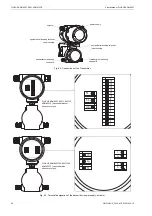
FLUXUS ADM 8027, F801, ADM 8127B
3 General Principles
12
UMFLUXUS_F8V4-6-1EN, 2018-10-10
Sound speed c
Speed of the propagating sound. The sound speed depends on the mechanical properties of the fluid or the pipe material.
In pipe materials and other solid materials, a distinction is made between the longitudinal and transversal sound speed.
For the sound speed of some fluids and materials see annex C.1.
Flow velocity v
Average value of all flow velocities of the fluid over the cross-sectional pipe area.
Acoustic calibration factor k
a
k
a
=
The acoustic calibration factor k
a
is a parameter of the transducer which results from the sound speed c within the trans-
ducer and the angle of incidence (see Fig. 3.2). According to Snell's law of refraction, the angle of propagation in the ad-
joining fluid or pipe material is:
k
a
=
=
=
Fluid mechanics correction factor k
Re
With the fluid mechanics correction factor k
Re
, the measured value of the flow velocity in the area of the sound beam is
converted into the value of the flow velocity across the whole cross-sectional pipe area. In case of a fully developed flow
profile, the fluid mechanics correction factor only depends on the Reynolds number and the roughness of the inner pipe
wall. The fluid mechanics correction factor is recalculated by the transmitter for each new measurement.
Volumetric flow rate
= v · A
The volume of the fluid that passes through the pipe per unit time. The volumetric flow rate is calculated from the product
of the flow velocity v and the cross-sectional pipe area A.
Mass flow rate
= ·
ρ
The mass of the fluid that passes through the pipe per unit time. The mass flow rate is calculated from the product of the
volumetric flow rate and the density
ρ
.
3.2.2
Measurement of the Flow Velocity in the TransitTime Mode
The signals are emitted and received by two transducers alternatively in and against the flow direction. If the fluid moves,
the signals propagating in the fluid are displaced with the flow. This displacement causes a reduction in distance for the
signal in the flow direction and an increase in distance for the signal against the flow direction in the section of the receiv-
ing transducer (see Fig. 3.2 and Fig. 3.3). This causes a change in the transit times. The transit time of the signal in the
flow direction is shorter than the transit time against the flow direction. This transit time difference is proportional to the av-
erage flow velocity.
The average flow velocity of the fluid is calculated as follows:
V = k
Re
. k
a
.
with
v
– average flow velocity of the fluid
k
Re
– fluid mechanics correction factor
k
a
– acoustic calibration factor
∆
t
– transit time difference
t
fl
– transit time in fluid
c
sin
------------
c
sin
------------
c
sin
------------
c
sin
-----------
V
·
V
·
m
·
m
·
V
·
V
·
t
2 t
fl
------------













































